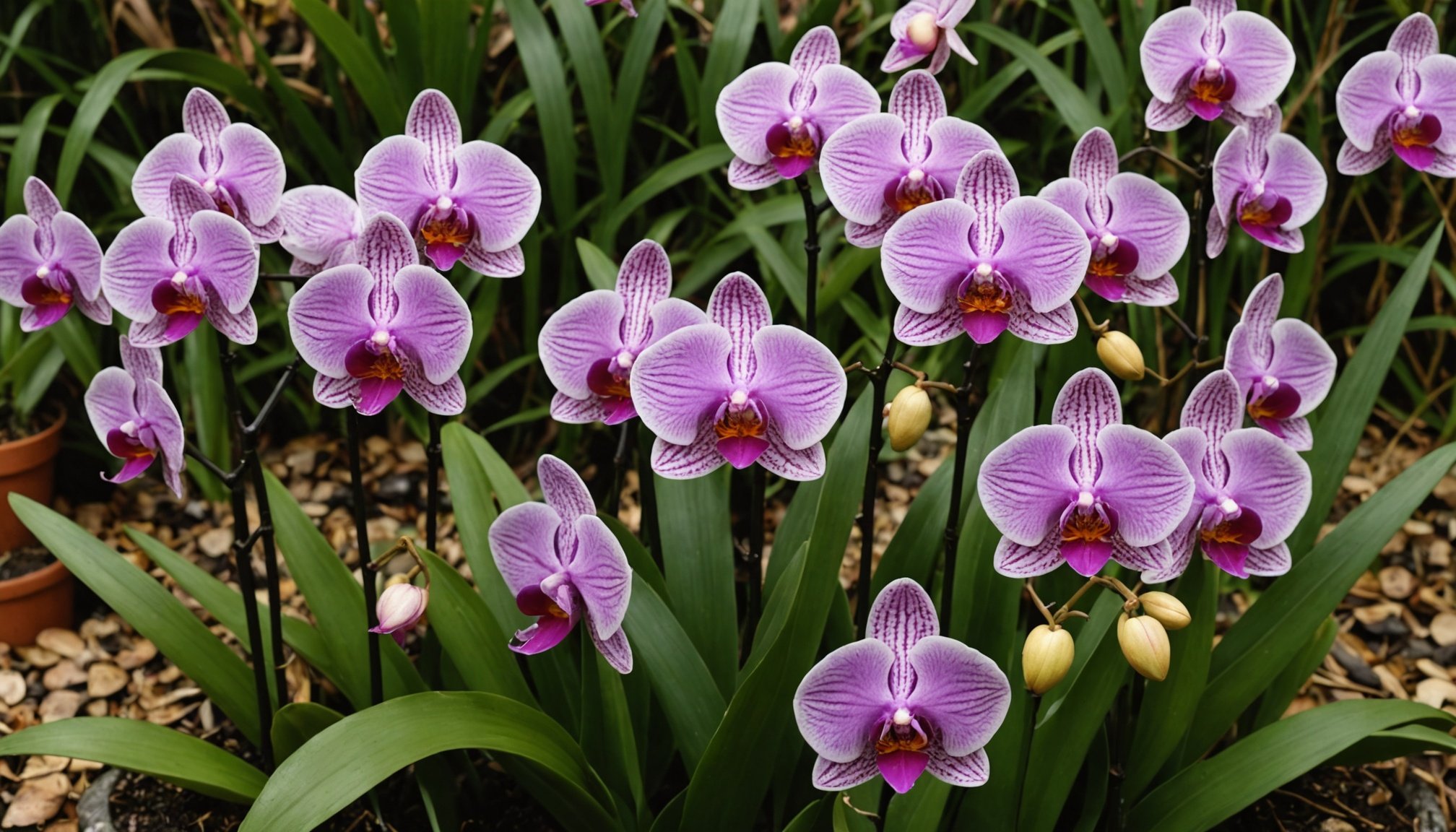Ultimate Guide to Thriving UK Orchids: Key Strategies for Cultivating a Vibrant Collection
Understanding Orchids: A Brief Overview
Orchids are one of the most diverse and fascinating groups of plants, with over 25,000 known species, each with its own unique characteristics and care requirements. From the elegant Phalaenopsis (moth orchids) to the exotic Vandas, understanding the specific needs of your orchid is crucial for its survival and blooming.
“When you bring home an orchid, it’s not just about having a beautiful plant; it’s about creating an environment that mimics its natural habitat,” explains Tony Le-Britton, a plant expert featured in House Beautiful[3].
Also read : Mastering blueberry growth: key strategies for thriving in acidic uk soil
Choosing the Right Orchid Species
With so many orchid species available, selecting the right one for your home can be daunting. Here are some of the most popular varieties and their specific care needs:
Phalaenopsis (Moth Orchids)
- These are one of the most common and easy-to-care-for orchids.
- They thrive in bright, indirect light and temperatures between 18 and 25°C[3].
Vandas
- These orchids prefer higher temperatures, between 20 and 30°C.
- They require full sun to partial shade and frequent watering[1].
Cymbidium and Slipper Orchids
- These species prefer cooler temperatures, between 15 and 20°C.
- They need bright, indirect light and careful watering to avoid root rot[1].
Orchid Care: Essential Tips
Light
Orchids love light, but not all light is equal. Here’s what you need to know:
Have you seen this : Mastering perennial vegetables: essential growing strategies for flourishing gardens in the uk
- Bright Indirect Light: Most orchids thrive in bright, indirect light. North-facing windowsills or east- or west-facing windows with diffused light are ideal[3].
- Avoid Direct Sunlight: Direct sunlight can burn the leaves and flowers of your orchid. If you can’t avoid direct sunlight, use a sheer curtain to filter the light.
Watering
Watering is one of the most critical aspects of orchid care. Here are some key tips:
- Use Lukewarm Water: Orchids prefer lukewarm water. Avoid using cold or hot water, as it can shock the roots[1].
- Check the Roots: For Phalaenopsis orchids, check the roots by looking through the clear plastic pot. Silver roots indicate the need for watering, while green roots mean they are hydrated[3].
- Watering Methods: You can water your orchid using a watering can, by spraying with a plant sprayer, or by giving it an immersion bath. Make sure the potting mix is slightly dry before watering again[1].
Temperature
Temperature is vital for the health and blooming of your orchid.
- General Temperature Range: Most orchids thrive in temperatures between 18 and 25°C. However, some species like Vandas prefer higher temperatures, while Cymbidium and Slipper Orchids prefer cooler temperatures[1].
- Avoid Heat Sources: Keep your orchid away from heat sources like radiators and heaters, as they can cause stress to the plant[1].
Humidity
Orchids generally prefer a humid environment, but this can be challenging to replicate in a home setting.
- Increase Humidity: You can increase humidity around your orchid by placing the pot on a tray filled with water and pebbles or using a humidifier[1].
Potting Mix and Repotting
The Right Potting Mix
Traditional soil is too dense for orchids and can lead to root rot. Here’s what you should use instead:
- Well-Draining Medium: Orchids need a well-draining and aerated growing medium. A mix of bark with peat is ideal, as it provides the necessary drainage and aeration[1][4].
Repotting
Repotting is essential for the health and growth of your orchid.
- Frequency: Repot your orchid every 3 years, preferably after it has finished flowering. This allows the plant to focus its energy on the roots rather than the flowers[1].
- Steps to Repot:
- Cut off any dead roots.
- Choose a pot that is slightly larger than the previous one.
- Use the right potting mix.
- Water the plant thoroughly after repotting[1].
Fertilizing Your Orchid
Fertilizing is crucial for promoting healthy growth and blooming.
- Balanced Fertilizer: Use a balanced fertilizer that is high in nitrogen and phosphorus. Nitrogen helps with leaf growth, while phosphorus promotes blooming[3].
- Fertilizing Schedule: Fertilize your orchid every other watering. Make sure to flush the pot with clean water after fertilizing to prevent any build-up in the pot[3].
Encouraging Re-Blooming
Getting your orchid to rebloom can be a challenge, but with the right techniques, it’s achievable.
Cutting the Flower Stem
- Once the flowers have finished blooming, cut the flower stem at the base, just above the bottom node. This directs the plant’s energy towards new growth[1][3].
Cooling Period
- Place your orchid in a cool place with sufficient indirect sunlight. Reducing watering for a few weeks can give the orchid a flowering boost[1][3].
Monitoring Growth
- Keep an eye out for new flower stalks. Once they appear, you can return the orchid to its normal spot and resume regular watering and fertilizing[1].
Additional Tips for Thriving Orchids
Using Lemon Juice
A simple and effective trick to keep your orchids healthy involves using lemon juice.
- Citric Acid Benefits: Lemon juice contains citric acid, which reduces water alkalinity and fights mold and bacteria. Mix one tablespoon of lemon juice with 500ml of room temperature water and use it to water your orchid. You can also rub the leaves with this mixture to keep them healthy[2].
Avoiding Common Mistakes
- Overwatering: This is one of the most common mistakes that can lead to root rot. Make sure the potting mix is slightly dry before watering again. Avoid getting water in the center of the orchid, as it can cause damage[2].
Propagating Orchids Using Keikis
Propagating orchids using keikis (baby plants) is a rewarding way to expand your orchid collection.
Steps to Propagate
- Identify the Keiki: Look for a dormant eye on the stem of the orchid from which no branching has grown yet.
- Prepare the Keiki: Remove the top skin from the eye with clean tweezers or a nail.
- Wait for Roots: Wait until the keiki develops roots that are at least 5 centimeters long.
- Separate the Keiki: Carefully twist or cut the keiki loose from the mother plant.
- Repot the Keiki: Plant the baby plant in a small pot with drainage holes using the right potting mix. Place the pot in a light, warm place with high humidity and water regularly[1].
Table: Comparative Care Requirements for Different Orchid Species
| Orchid Species | Temperature Range | Light Requirements | Watering Frequency | Humidity Needs |
|---|---|---|---|---|
| Phalaenopsis | 18-25°C | Bright, indirect light | Once a week | Moderate humidity |
| Vandas | 20-30°C | Full sun to partial shade | More frequent | High humidity |
| Cymbidium | 15-20°C | Bright, indirect light | Less frequent | Moderate humidity |
| Slipper Orchids | 15-20°C | Bright, indirect light | Less frequent | Moderate humidity |
Practical Insights and Actionable Advice
- Monitor Your Plant: Regularly check your orchid’s leaves, roots, and flowers for any signs of stress or disease.
- Adjust Care Seasonally: Adjust your watering and fertilizing schedule based on the season. Orchids generally need more water and fertilizer during the growing season (spring and summer)[1][3].
- Keep Records: Keep a journal of your orchid’s care to track what works and what doesn’t. This can help you refine your care techniques over time.
Cultivating a vibrant collection of orchids requires attention to detail, patience, and a deep understanding of their specific needs. By providing the right light, water, temperature, and care, you can enjoy the beauty and elegance of these incredible plants for years to come.
“As I’ve had my Phalaenopsis orchid for 18 years, I can attest that with the right care, these plants can thrive and continue to bloom beautifully,” says Tony Le-Britton[3].
With these strategies and tips, you’re well on your way to becoming an expert in orchid care and enjoying the rewarding experience of growing these stunning plants.



